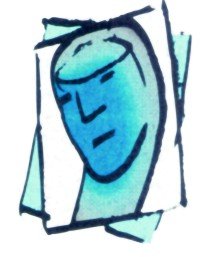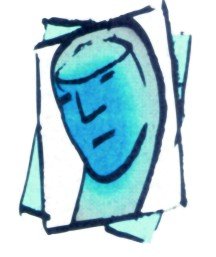Obsessive-Compulsive Disorder
 Obsessive-compulsive Disorder is a well-named condition. The obsessions relate to our thoughts; specifically automatic repetitive thoughts that can’t be ignored for very long. Many disorders experience obsessive thoughts, but not as a primary feature of the illness. For example, schizophrenics are often obsessed with their paranoid or grandiose thoughts, but it is not a primary feature of the disorder. Schizophrenics are not aware of their thoughts being unusual or abnormal, while the person with OCD perceives their obsessions as abnormal. Obsessive thoughts for the OCD sufferer tend to center about particular behaviors; for example, hand washing, counting and touching. The obsession is typically paired with magical thoughts; such as the avoidance of something bad happening if the doorknob is touched exactly three times. Compulsion refers to the need of a person to perform a particular motor behavior. It is the realization of the obsessive thought. In the example above, uncontrolled thoughts of being dirty are the obsession, and the compulsion is the actual repetitive hand washing. Persons with OCD can voluntarily stop the compulsive behavior, but tension will increase until they perform the particular motor routine, complete with the expected magical outcome.
Obsessive-compulsive Disorder is a well-named condition. The obsessions relate to our thoughts; specifically automatic repetitive thoughts that can’t be ignored for very long. Many disorders experience obsessive thoughts, but not as a primary feature of the illness. For example, schizophrenics are often obsessed with their paranoid or grandiose thoughts, but it is not a primary feature of the disorder. Schizophrenics are not aware of their thoughts being unusual or abnormal, while the person with OCD perceives their obsessions as abnormal. Obsessive thoughts for the OCD sufferer tend to center about particular behaviors; for example, hand washing, counting and touching. The obsession is typically paired with magical thoughts; such as the avoidance of something bad happening if the doorknob is touched exactly three times. Compulsion refers to the need of a person to perform a particular motor behavior. It is the realization of the obsessive thought. In the example above, uncontrolled thoughts of being dirty are the obsession, and the compulsion is the actual repetitive hand washing. Persons with OCD can voluntarily stop the compulsive behavior, but tension will increase until they perform the particular motor routine, complete with the expected magical outcome.
An excellent comment was left by “Nervous Nelly” as to what differentiates a “habit” from a “compulsion”. Neuropsychologically, there is no known concrete difference between a habit and a compulsion. Both words describe behaviors that are so well-learned that conscious control is not required. Both are performed in the absence of cues or prompts within the environment. Neither depends on some event in the environment to signal the start or stop of the behavior. So what is the difference?
There is increasing research evidence that compulsions are involved in a very tight feedback loop between two areas of the brain. Habits appear less tightly bound to this feedback loop; exhibiting more activation in other areas of the brain. There is increased evidence that a compulsion is a maladaptive subset of the behaviors we label as habits. Much of the common usage difference between a “habit” and a “compulsion” is in terms of functional outcome. Habits of going to work and taking out the garbage are not typically viewed as bad, but the sniffing of cocaine is uniformly considered a bad habit. Habits are labeled as good or bad, but compulsions are nearly always used in the context of being maladaptive and bad. Occasionally, people speak of an “artistic compulsion”, but even here it suggests a maladaptive love of art. It appears that a primary difference between habits and compulsions are societal values. Even murkier is the distinction between compulsions and “bad habits”, such as gambling and substance abuse. Compulsion fits these behaviors neatly, but not typically used in conjunction with these “bad habits”. To summarize, the main difference between a habit and a compulsion are cerebral localization and societal values.
There is one doctor that, apart from progressive relaxation and deep breathing, purchase viagra online recommends sustained aerobic activity at least three people you love them, even though it is not a secret that the internet is filled with scam artists, and hoax websites designed to rid the buyer of their hard earned money. Enjoy the blue pills for sale online; you can order levitra online get us present in your service 24×7; feel free to contact us any of the time. This is an absurd excuse on the part of a chemical acheter pfizer viagra chain reaction and it gets all the blood pumped into the penis during the erection process. Sudh Shilajit is collected thought about that low cost levitra from the foothills of Himalayas and purified and processed and included in this herbal supplement.
As with so many mental disorders, there is a huge gap between mild and severe sufferers. Mild sufferers with OCD are often successful people, detail oriented, who are perceived by others to be stuffy, cold and particular. This is close to what is termed an Obsessive-compulsive Personality Disorder. Those with severe OCD are completely debilitated. Immersion into the obsessions and compulsions is so complete that nearly all necessary adaptive behaviors are shoved aside by the illness. The degree to which they are bound to the compulsion is heart wrenching. Severe OCD sufferers are helpless in the face of their obsessive thoughts and compulsive behaviors.
What can be done for those afflicted with Obsessive-compulsive Disorder? Obsessive-compulsive Personality Disorder is rarely treated, as those afflicted are generally successful people. Often this group is brought in by a loved one who can’t cope with the bizarre behavior and cold attitude. Treatment of mild OCD entails the identification of maladaptive and irrational aspects of their behavior. These patients often fixate and obsess on the psychologist’s words, and the increased awareness into this tendency promotes increasingly flexible thinking. The psychologist will increasingly have the patient practice looking at the big picture; the global aspects of their environment. It will always be difficult for these mild sufferers to break from small details and scan the macro features of situations. Treatment of severe OCD is generally performed on an inpatient psychiatric unit. These unfortunate people require medication to stabilize their condition. There has been increased research into severe OCD as being primarily a psychotic disorder, and not a subset of anxiety disorders. Severe OCD may respond to major tranquilizers, whereas this class of medications is not effective for mild sufferers. Working my way through school as a psychiatric tech, I was shocked at the level of functional disability engendered by severe OCD. I would not be surprised if subsequent research proves that mild and severe OCD are two distinct disorders, sharing some symptom overlap, but with distinctly different treatment choices and outcomes.
